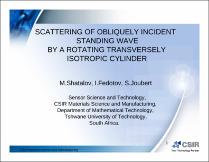 ResearchSpace
ResearchSpace
Scattering of obliquely incident standing wave by a rotating transversely isotropic cylinder
JavaScript is disabled for your browser. Some features of this site may not work without it.
- ResearchSpace
- →
- Research Publications/Outputs
- →
- Conference Publications
- →
- View Item
| dc.contributor.author |
Shatalov, MY

|
|
| dc.contributor.author |
Fedotov, I

|
|
| dc.contributor.author |
Joubert, S

|
|
| dc.date.accessioned | 2009-03-09T10:12:09Z | |
| dc.date.available | 2009-03-09T10:12:09Z | |
| dc.date.issued | 2006-05 | |
| dc.identifier.citation | Days on Diffraction, St. Petersburg, Russia, 30 May to 02 June, pp 26 | en |
| dc.identifier.uri | http://hdl.handle.net/10204/3179 | |
| dc.description | Days on Diffraction, St. Petersburg, Russia, 30 May to 02 June 2006 | en |
| dc.description.abstract | It is known that vibrating patterns of an isotropic cylinder, subjected to inertial rotation over the symmetry axis, precess in the direction of rotation with a different angular rate. The proportionality coefficient, or the so-called Bryan factor, equal to the ratio of vibrating patterns rate to the inertial angular rate, depend on particular thickness modes as well as circumferential wave numbers. This effect is retained in the case of a transversely isotropic cylinder if the axis of anisotropy coincides with the axis of the cylinder. In the present paper, the authors consider the case when the vibrating patterns of a rotating transversely isotropic cylinder are generated by an obliquely incident plane acoustic wave. In this case the capture effect exists, which demonstrate finite angular declinations of particular vibrating patterns at different angles depending on modes and circumferential numbers. The resulting scattered acoustic field is very specific, because the lower mode components, corresponding to the lower circumferential wave numbers are found to be turned over the cylinder’s axis at higher angles compare to the higher modes. The angles of relative rotations of the modes are proportional to the abovementioned Bryan factors. These effects in the scattered patterns of the solid cylinder due to the inertial rotation are investigated | en |
| dc.language.iso | en | en |
| dc.subject | Bryan's effect | en |
| dc.subject | Transversely isotropic cylinders | en |
| dc.title | Scattering of obliquely incident standing wave by a rotating transversely isotropic cylinder | en |
| dc.type | Conference Presentation | en |
| dc.identifier.apacitation | Shatalov, M., Fedotov, I., & Joubert, S. (2006). Scattering of obliquely incident standing wave by a rotating transversely isotropic cylinder. http://hdl.handle.net/10204/3179 | en_ZA |
| dc.identifier.chicagocitation | Shatalov, MY, I Fedotov, and S Joubert. "Scattering of obliquely incident standing wave by a rotating transversely isotropic cylinder." (2006): http://hdl.handle.net/10204/3179 | en_ZA |
| dc.identifier.vancouvercitation | Shatalov M, Fedotov I, Joubert S, Scattering of obliquely incident standing wave by a rotating transversely isotropic cylinder; 2006. http://hdl.handle.net/10204/3179 . | en_ZA |
| dc.identifier.ris | TY - Conference Presentation AU - Shatalov, MY AU - Fedotov, I AU - Joubert, S AB - It is known that vibrating patterns of an isotropic cylinder, subjected to inertial rotation over the symmetry axis, precess in the direction of rotation with a different angular rate. The proportionality coefficient, or the so-called Bryan factor, equal to the ratio of vibrating patterns rate to the inertial angular rate, depend on particular thickness modes as well as circumferential wave numbers. This effect is retained in the case of a transversely isotropic cylinder if the axis of anisotropy coincides with the axis of the cylinder. In the present paper, the authors consider the case when the vibrating patterns of a rotating transversely isotropic cylinder are generated by an obliquely incident plane acoustic wave. In this case the capture effect exists, which demonstrate finite angular declinations of particular vibrating patterns at different angles depending on modes and circumferential numbers. The resulting scattered acoustic field is very specific, because the lower mode components, corresponding to the lower circumferential wave numbers are found to be turned over the cylinder’s axis at higher angles compare to the higher modes. The angles of relative rotations of the modes are proportional to the abovementioned Bryan factors. These effects in the scattered patterns of the solid cylinder due to the inertial rotation are investigated DA - 2006-05 DB - ResearchSpace DP - CSIR KW - Bryan's effect KW - Transversely isotropic cylinders LK - https://researchspace.csir.co.za PY - 2006 T1 - Scattering of obliquely incident standing wave by a rotating transversely isotropic cylinder TI - Scattering of obliquely incident standing wave by a rotating transversely isotropic cylinder UR - http://hdl.handle.net/10204/3179 ER - | en_ZA |





